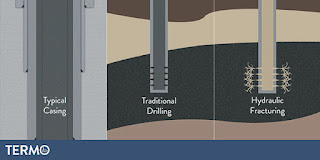No, oil drilling and fracking are not the same, although they are related to the extraction of oil and natural gas. Here is an overview of each market and size.
Oil drilling, also known as oil exploration or oil extraction, refers to the process of drilling a well into the Earth's surface to access underground oil reservoirs. This involves drilling a hole vertically or at an angle to reach the target oil-bearing rock formations. Once the well is drilled, it may be equipped with production equipment to extract oil from the reservoir, such as pumps and pipes. Drilling simply pulls from the oil and natural gas that are readily available in the reservoir.
Fracking, or hydraulic fracturing, is a specific technique used in the extraction of natural gas and, to a lesser extent, oil from underground rock formations. It involves the injection of large volumes of water, sand, and chemical additives into the well at high pressure to fracture the rocks and release the trapped gas or oil. These fractures create pathways for the hydrocarbons to flow to the wellbore, where they can be extracted. Fracking is also known as hydraulic fracturing. Fracking takes place after the well has been drilled, cased, and cemented.
While fracking is a method used within the broader process of oil drilling, not all oil drilling operations involve fracking. Conventional oil drilling typically targets reservoirs where the oil flows more freely and does not require hydraulic fracturing. However, in some cases, unconventional oil and gas resources, such as shale formations, require fracking to extract hydrocarbons from the tight rock formations.
Both oil drilling and fracking can have environmental impacts, including the potential for groundwater contamination, air pollution, and induced seismic activity. Regulations and practices vary across jurisdictions to mitigate these risks.
In terms of scale, oil drilling is generally a larger industry than fracking. Oil drilling encompasses a broad range of activities involved in the exploration, extraction, and production of oil from underground reservoirs. This includes the drilling of conventional oil wells, offshore drilling, and various enhanced oil recovery techniques.
Fracking, on the other hand, is a specific technique used to extract natural gas and, to a lesser extent, oil from unconventional resources like shale formations. While fracking has gained significant attention in recent years due to its impact on the energy industry and the environment, it represents a subset of the overall oil and gas drilling operations.
How big is the fracking market?
The fracking market, also known as the hydraulic fracturing market, has experienced significant growth over the past few decades. It has played a crucial role in the development of unconventional oil and gas resources, particularly shale gas and tight oil.
The market size of fracking can be assessed through various factors, including the revenue generated by companies involved in providing fracking services, the number of wells fractured, and the overall investment in the industry.
According to a report by Grand View Research published in 2020, the global hydraulic fracturing market was valued at approximately USD 35.3 billion in 2019. The market is projected to witness a compound annual growth rate (CAGR) of around 8.8% from 2020 to 2027. The report attributes this growth to the increasing exploration and production activities in shale gas and tight oil reservoirs, primarily in North America.
North America, particularly the United States, has been a key region for fracking activities. The widespread development of shale formations, such as the Marcellus, Bakken, and Permian basins, has propelled the growth of the fracking market in this region. The United States has been a major contributor to global fracking revenues.

